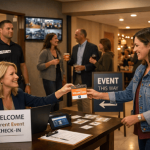
In outpatient and specialty care clinics, the waiting room is more than just a space—it’s a gateway. It’s where security, privacy, efficiency, and compassion must all coexist.
Unlike hospitals, these clinics often have smaller teams, less formal security infrastructure, and a higher volume of short-term visitors—patients, family members, caregivers, vendors, and reps—all moving in and out throughout the day.
At SSP, we’re seeing a major shift in how these clinics are handling visitor access. Here’s how modern outpatient clinic visitor policies are evolving—and how to stay ahead of the curve.
k
k
🚪 The Challenges of Visitor Management in Clinics
Most outpatient clinics face a blend of unique issues:
-
Limited staff available to monitor front desks full-time
-
Sensitive patient conversations happening just steps from public areas
-
Visiting family, medical reps, delivery personnel, and contractors sharing space
-
HIPAA and compliance requirements without hospital-scale infrastructure
The result? Many clinics unintentionally leave doors open—literally and figuratively.
k
k
📋 Why Traditional Sign-In Sheets Are No Longer Enough
Pen-and-paper logs or verbal check-ins:
-
Don’t verify identity
-
Leave no audit trail for security or compliance
-
Can expose personal information to other visitors
-
Are easily forgotten during peak hours or emergencies
Today’s visitor management systems need to be smarter, faster, and more discreet—not just for safety, but to support a positive patient experience.
k
k
💡 How Visitor Management Is Changing (And What Works Now)
1. Digital Kiosks with Contactless Check-In
Modern clinics are using kiosks or tablets to:
-
Check in patients and guests
-
Collect names, contact details, and visit purposes
-
Print temporary visitor badges
-
Trigger alerts if someone tries to enter a restricted area
Bonus: These systems can auto-notify staff when a visitor has arrived, reducing wait times and lobby crowding.
k
k
2. Pre-Authorized Visitor Scheduling
Some clinics—especially in specialty fields like oncology, pediatrics, or behavioral health—are now offering pre-registration or visitor pre-approval.
This enables:
-
Faster check-ins for caregivers or family
-
Background screening for vendors
-
Controlled access windows for delivery drop-offs
This adds a layer of predictability and control, especially for clinics with narrow hallways or sensitive treatment areas.
k
k
3. Access Zone Restriction by Role
Not all visitors need full access.
Smart visitor policies now assign access by:
-
Role (vendor, caregiver, contractor, etc.)
-
Time of day (e.g., after-hours restrictions)
-
Zone (waiting room only, consult room, supply room access denied)
This helps clinics stay compliant with HIPAA and reduce the risk of wandering guests in treatment or records areas.
k
k
4. Secure Visitor Logs for Compliance & Safety
Modern visitor systems create digital audit trails—including:
-
Time of arrival and departure
-
Who authorized the visit
-
What doors were accessed (if tied to access control)
This information is essential during:
-
Incident reviews
-
HIPAA audits
-
Emergency drills or real-life lockdowns
And unlike paper logs, it’s not lost, messy, or vulnerable to prying eyes.
k
k
🔐 Why This Matters for Patient Experience
Yes, visitor management is about safety—but it’s also about feeling cared for.
Patients and guests often judge your clinic by their first five minutes. A thoughtful visitor policy:
-
Prevents awkward crowding or confusion
-
Protects sensitive conversations
-
Reinforces professionalism and trust
-
Keeps your team focused on care—not chaos
In short: security is part of the experience.
k
k
SSP Helps Clinics Build Smarter Visitor Policies
At SSP, we help outpatient clinics:
-
Select and implement the right visitor management platform
-
Integrate check-in systems with access control
-
Train staff on best practices
-
Create visitor flows that feel secure—but never sterile
Whether you manage a stand-alone specialty clinic or a multi-site medical group, we can help you develop a visitor policy that works for your team, your patients, and your space.


